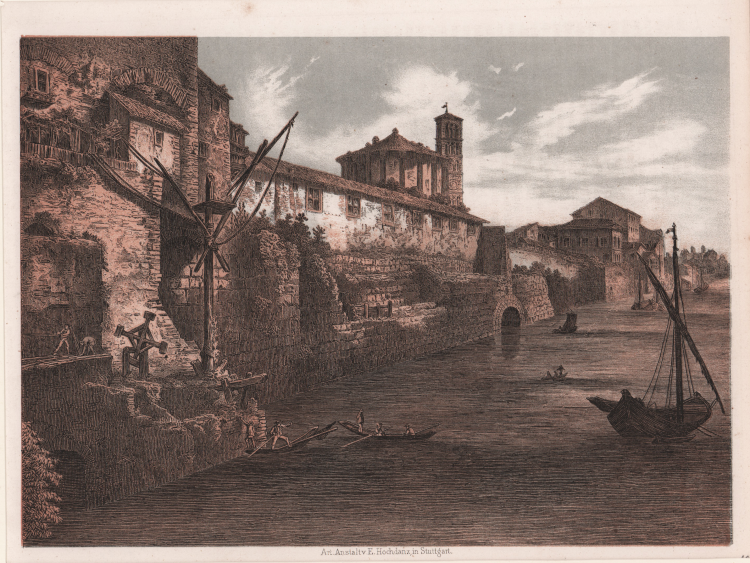



| Reference: | S39030 |
| Author | Emil Hochdanz |
| Year: | 1870 |
| Zone: | Cloaca Massima |
| Measures: | 250 x 190 mm |


| Reference: | S39030 |
| Author | Emil Hochdanz |
| Year: | 1870 |
| Zone: | Cloaca Massima |
| Measures: | 250 x 190 mm |
From the series: Album des Classischen Alterthums zur Anschauung für die Jugend… Eine Gallerie von LXXII Tafeln in Farbendruck …von Hermann Rheinard – Stuttgard - Hoffmann’sche Verlags – Buchlandlung – 1870.
The 'Album des Classischen Alterthums' ('Album of Classical Antiquity') containing seventy-six [72 in the first edition] admirably executed chromo-lithographs of objects of ancient mythology, art, domestic and public life, warfare, commerce, costume, etc. Reinhard's descriptions are written in an easy, pleasant style, and make the work particularly suitable for general reading, as well as for the higher classes of schools." (The Critic, Volume 2, 1882)
A gallery of 72 panels in color done from nature and from reconstructed models of ancient Greek and Roman structures, sculptures, vases etc. accompanied by descriptive text. The lithographs includes beautiful views of Athens (Acropolis, Erechteum), Sparta, Corinth, Pompeii, Paestum, Rome, Tivoli, etc.
Chromo-lithograph, signed lower right Art. Emil Hochdanz Stutgart. Very good condition.
Emil Hochdanz (2 febbraio 1816 a Nohra presso Weimar, 20 febbraio 1885 a Stoccarda)
|
Emil Hochdanz (born February 2, 1816 in Nohra near Weimar; died February 20, 1885 in Stuttgart) was a German lithographer and publisher.
In Weimar, Emil Hochdanz completed an apprenticeship as a lithographer and then worked at the lithographic institute of Bernhard Friedrich Voigt. At the end of the 1830s, Hochdanz moved to the Lithographisch Artistische Kunstinstitut of Johannes Velten (1784-1864) in Karlsruhe and in the early 1940s to the lithographic institute Pobuda & Rees in Stuttgart.
His work and talent for caricature attracted the attention of the publishing bookseller Carl Hoffmann (1802-1883), who employed Hochdanz for several years. In 1844, Hoffmann, together with Mathilde Courtin, initiated the founding of the "Allgemeine Muster-Zeitung", with its pattern sheets the model for many other illustrated fashion newspapers that entered the market in the second half of the 19th century. To publish this paper, Hochdanz and his friend Johann Christoph Engelhorn (1818-1890) founded a lithographic establishment and a publishing company under the name Engelhorn & Hochdanz, which existed until 1860. After the dissolution of the company, Hochdanz took over the lithographic establishment on his own and continued to run the sample newspaper for a few more years until he handed it over to the Metzlersche Buchhandlung.
For many years, his company provided outstanding services in the field of map engraving and lithographic color printing for a wide variety of clients, which gave his company an excellent reputation. When Emil Hochdanz died in 1885 at the age of 69, the business was taken over by his eldest son Carl, who had already been working in his father's company since 1876. The technical manager was first Paul Wagner, later Hermann Friese, under whose leadership the Emil Hochdanz company was able to maintain its reputation even after the death of the founder. In 1899, Hermann Friese and Walther Hopf acquired the company, which lasted until the early 1920s.
|
Emil Hochdanz (2 febbraio 1816 a Nohra presso Weimar, 20 febbraio 1885 a Stoccarda)
|
Emil Hochdanz (born February 2, 1816 in Nohra near Weimar; died February 20, 1885 in Stuttgart) was a German lithographer and publisher.
In Weimar, Emil Hochdanz completed an apprenticeship as a lithographer and then worked at the lithographic institute of Bernhard Friedrich Voigt. At the end of the 1830s, Hochdanz moved to the Lithographisch Artistische Kunstinstitut of Johannes Velten (1784-1864) in Karlsruhe and in the early 1940s to the lithographic institute Pobuda & Rees in Stuttgart.
His work and talent for caricature attracted the attention of the publishing bookseller Carl Hoffmann (1802-1883), who employed Hochdanz for several years. In 1844, Hoffmann, together with Mathilde Courtin, initiated the founding of the "Allgemeine Muster-Zeitung", with its pattern sheets the model for many other illustrated fashion newspapers that entered the market in the second half of the 19th century. To publish this paper, Hochdanz and his friend Johann Christoph Engelhorn (1818-1890) founded a lithographic establishment and a publishing company under the name Engelhorn & Hochdanz, which existed until 1860. After the dissolution of the company, Hochdanz took over the lithographic establishment on his own and continued to run the sample newspaper for a few more years until he handed it over to the Metzlersche Buchhandlung.
For many years, his company provided outstanding services in the field of map engraving and lithographic color printing for a wide variety of clients, which gave his company an excellent reputation. When Emil Hochdanz died in 1885 at the age of 69, the business was taken over by his eldest son Carl, who had already been working in his father's company since 1876. The technical manager was first Paul Wagner, later Hermann Friese, under whose leadership the Emil Hochdanz company was able to maintain its reputation even after the death of the founder. In 1899, Hermann Friese and Walther Hopf acquired the company, which lasted until the early 1920s.
|